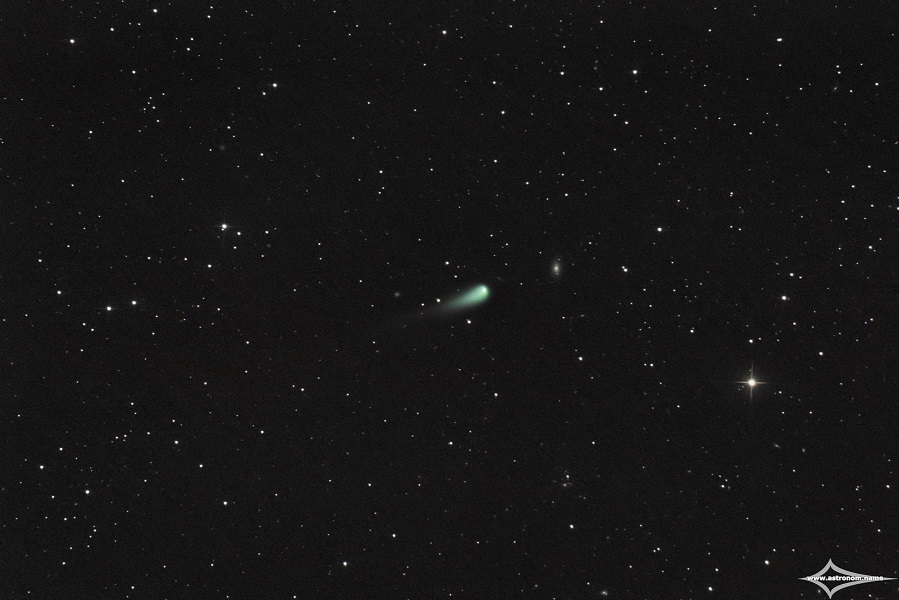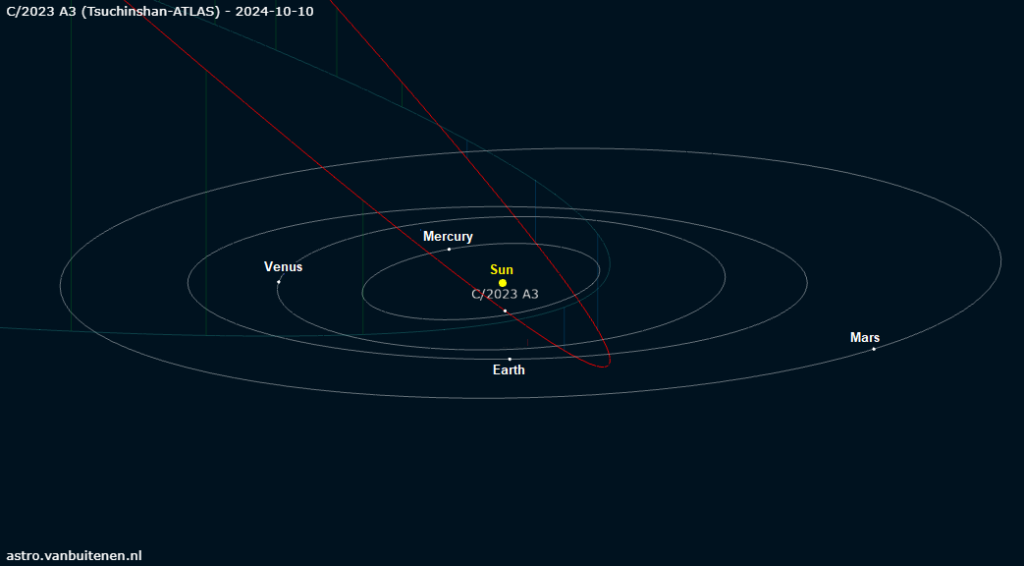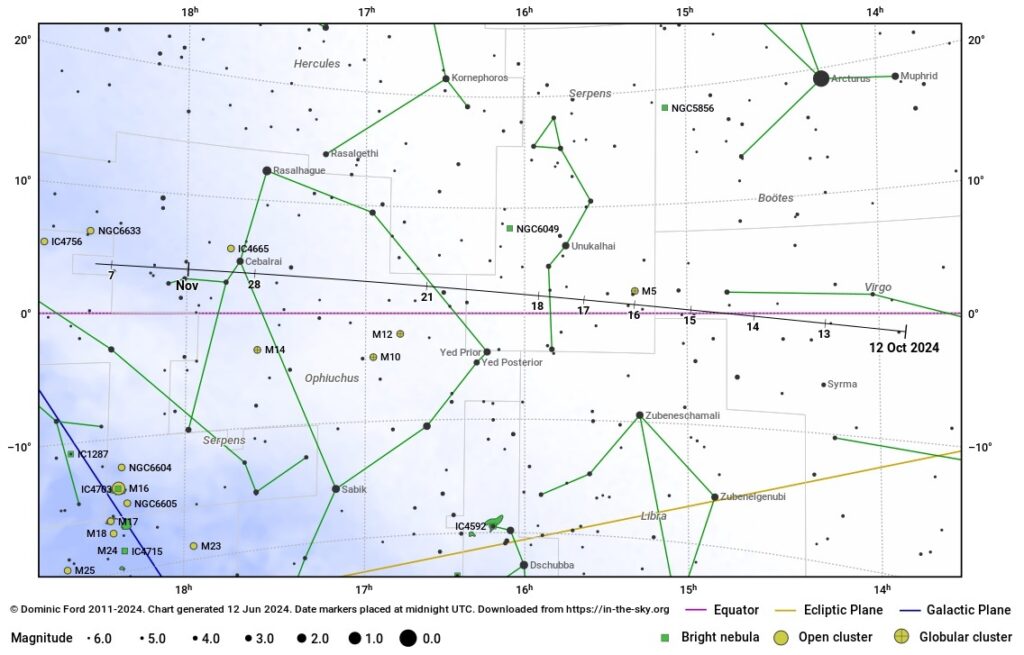China’s Zijinshan (Purple Mountain) Observatory, after becoming famous 60 years ago for the discovery of two periodic comets, continues its successful scientific work. By the way, it was involved in the discovery of a comet, which in the autumn may become the brightest “tail star” in 2024. It was first noticed on January 9, 2023.
On February 22, the new object was photographed by the South African half-meter telescope of the ATLAS automated system, after which it was identified as a comet and designated C/2023 A3 (Tsuchinshan-ATLAS). At the time of its discovery, it was more than 7 AU (1.05 billion kilometers) away from the Sun. Based on its apparent brilliance (about 18ᵐ), scientists estimated the size of its core at 10-15 km, which is comparable to the famous Halley’s Comet. Calculations of the orbital motion of C / 2023 A3 showed that it would pass perihelion on September 27, 2024, at a heliocentric distance of 0.391 A.E. (58.6 million km), and on October 12 would approach 0.472 A.E. (70.6 million km) to Earth. At this time its total brightness will reach the second stellar magnitude, and according to some estimates – even zero.
Already in early April, when the comet’s brilliance exceeded the tenth magnitude, Ukrainian amateur astronomers could see it at midnight quite high above the southern part of the horizon in the constellation Virgo using instruments with a lens diameter of at least 15 cm. Since then, the brightness of the “tail star” has increased slightly, but observing conditions have worsened as its height at the upper culmination has decreased. On June 13 and 14, the Moon will be near the comet, which in the next 10 days will greatly reduce its visibility, and then it will appear at the end of the evening nautical twilight at an altitude of only 12°, and each next day lower and lower, until July 13 will not disappear completely. In southern Ukraine, the “pre-perihelion” visibility of C / 2023 A3 will last about a week longer.

Further comet Tsuchinshan-ATLAS can be observed only in the Southern Hemisphere, but even there it will hide in the halo of the Sun until the end of summer, and on September 3, it will be at the minimum angular distance from the Sun (a little more than 11°). On September 21, this indicator will exceed 20°, and in a couple more days, C/2023 A3 can be tried again to see in our latitudes. September 27, that is, on the day of the perihelion, at 6 a.m. for observers in Kyiv, the “tail guest” will be 2° above the horizon. However, it will already be the middle of the nautical twilight, so it is better to use at least small binoculars for searching. But according to some predictions, the comet’s brilliance may reach zero at that point, so it won’t be difficult to find it.
After passing perihelion, the comet’s orbit will turn relative to the Earth in such a way that, despite the distance of C/2023 A3 from the Sun, it will begin to approach it again from the point of view of ground-based observers. Accordingly, the conditions of its visibility will worsen again. On September 9, the comet will be located less than 4° from our luminary. The next day it will move to the evening sky, on September 12, as already mentioned, it will come to the minimum distance to the Earth and will reach the greatest brilliance, and on the 13th, at the end of the nautical twilight, it can be found at 5° above the horizon, almost above the point of geodesic sunset.

On the evening of October 15, owners of large telescopes (at least 20 cm in diameter) will be able to see a rare conjunction of two comets, Tsuchinshan-ATLAS and Olbers (13P/Olbers). However, the brilliance of the latter at this time is unlikely to exceed 11ᵐ, so it will be very difficult to see it in the twilight sky. The visible distance between the celestial bodies will be a little more than a degree.
From there, C/2023 A3 will move away from the Sun, losing brilliance rather quickly. But if in space its distancing will continue further, in the sky, given the location of the comet’s orbit, it will become slower and slower, and finally on November 4, the comet will reach a maximum elongation of 56.5°, after which we will see as if it were… approaching our sun again. At that time, it will be in the constellation Ophiuchus, and for a few days afterward, it will move near the picturesque scattered star cluster NGC 6633.

Of course, all long-term predictions about the brilliance of “tail stars” should be taken with caution, but it is believed that somewhere in early October, comet Tsuchinshan-ATLAS will cease to be visible to the naked eye. By the end of the year, its brightness will drop to 10th magnitude. On November 24, it will move into the constellation Aquila, and on December 31, it will be 3° from its brightest star, Altair.
Experienced comet observers will understand from the above that the conditions of visibility of C/2023 A3 in our latitudes will not be very favorable, even if its luminosity at maximum reaches negative stellar magnitudes. But it looks like we won’t be seeing a brighter comet this year anyway. Therefore, it is highly recommended to spend at least a little time observing it, especially since the eccentricity of its orbit is greater than one, that is, it moves in a hyperbolic trajectory and will never return to the Sun again.
By the way, after the publication of our material about comet Brewington, there are new observations of it, which allow us to make a moderately optimistic forecast of further growth of its brightness.


